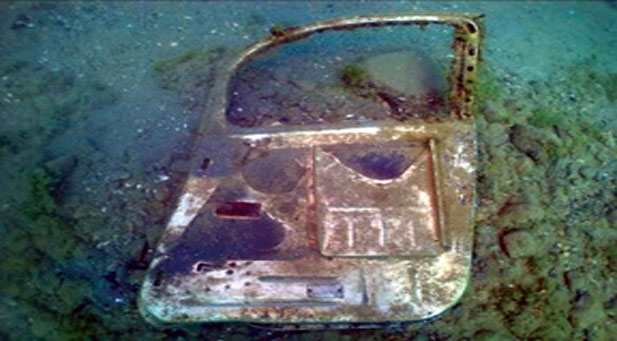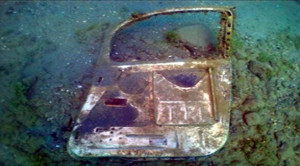
 Divers discover Tuskegee Airmen’s secrets in Lake Huron
Divers discover Tuskegee Airmen’s secrets in Lake Huron
By Michael Cottman, Urban News Service
For Erik Denson, a NASA engineer at the Kennedy Space Center, descending 30 feet into the depths of Lake Huron to help preserve the legacy of the Tuskegee Airmen was a cherished, unforgettable experience.
“I embarked on a mission of a lifetime,” said Denson, a graduate of Howard University. “One that would touch our hearts and souls.”
Early last summer, Denson and six other underwater explorers made history by conducting a five-day archeological survey of a Bell P-39Q Airacobra fighter plane piloted by 2nd Lt. Frank Moody, a 22-year-old Tuskegee Airman from Los Angeles. After crashing his plane on April 11, 1944, his body washed ashore in Port Huron, Michigan, a few months later.
The Tuskegee Airmen were a group of fighter and bomber pilots who fought in World War II and were the first African-American military aviators in the U.S. Armed Forces. Moody was flying a training mission over Lake Huron when his air-craft malfunctioned. He was one of seven documented Tuskegee Airman whose planes nose-dived into the Great Lakes as they trained to battle the Nazis in Europe.
David Losinski, a helicopter pilot with the Oakland County Sheriff’s Office, and his son, Drew, were in a boat helping the Michigan Department of Environmental Quality on an unrelated project when they spotted the submerged door of Moody’s airplane.
Losinski discovered Moody’s plane on April 11, 2014 — 70 years to the day after the pilot’s accident — and alerted archeologists from the Thunder Bay National Marine Sanctuary.
Denson, who works in eastern Florida, was part of the seven-person volunteer team that documented the wreckage, which included the engine, tail, gauge panel, wings and a radio. It marked the first time that Black underwater explorers helped examine the remains of a submerged airplane once piloted by a Tuskegee Airman.
“As an alumnus of Tuskegee, I had heard of the Airmen, but at that time in my life, it didn’t have much meaning,” said Ernest Franklin, who was part of last summer’s mission. “But as the week progressed . . . I started getting closer to 2nd Lt. Frank Moody, the pilot that died in the plane we were documenting.”
The Tuskegee Airmen for-med the 332nd Fighter Group and the 477th Bombardment Group of the United States Army Air Forces. When the pi-lots of the 332nd Fighter Group put red paint on the tails of their P-47s and later, P-51s, the nickname Red Tails was coined.
But despite their superior military abilities, they were still subjected to the South’s racially segregationist Jim Crow laws.
According to Wayne R. Lusardi, a marine archeologist for the state of Michigan and the archeological mission’s principal investigator, the region played a pivotal role for the Tuskegee Airmen.
“During the middle years of World War II, Michigan was home to several African-American air combat units including many graduates of the Tuskegee pilot training program,” Lusardi wrote in an internal state report about the archeological mission and the rich history behind it.
“While US Navy aviators were qualifying on makeshift aircraft carriers in Lake Michigan, far from the perils of the European and Pacific theaters, Army Air Force pilots were likewise simulating aerial combat and bombing exercises over Lake Huron,” he wrote.
The African-American divers who surveyed Moody’s plane said their experience was emotionally — and historically — rewarding.
“The Tuskegee Airmen pilots were one of my inspirations for becoming an electrical engineer,” said Jay Haigler, a scuba diver from Washington who helped examine Moody’s airplane. “These brave men battled through racism while learning technical skills such as aeronautics and aerial combat fighting.”
He said the team located the plane’s wing — which was intact — and then removed seven decades worth of debris from it.
“It was amazing to see the wing of the plane once it was cleaned,” Haigler said. “The star insignia (for the US Army Air Force Planes) could be seen on the tip of one of the wings. This was amazing to see this image. My heart was filled with emotion, my eyes filled with tears. This image was bringing Officer Frank Moody to life.”
Haigler also said members of the team found an intact cockpit window.
“The last person who probably looked through this glass,” Haigler said, “was Officer Frank Moody.”
Moody was born in Castle, Oklahoma, on Dec. 18, 1921, according to historians. He entered the United States Army and graduated from Tuskegee University on Feb. 8, 1944 with the rank of 2nd Lieutenant.
Moody’s fighter craft was part of a four-plane flight that had taken off from Selfridge Field, an aviation-training facility near Mount Clemens, Michigan, Lusardi said.
Military investigators concluded that Moody’s formation had been flying low, approximately 50 feet to 100 feet above the water, Lusardi said. They were lined up abreast with the flight leader slightly ahead when the accident occurred. Lt. Moody had just fired two bursts into the water when small pieces of debris were seen coming from the front right side of his plane. Lt. Moody’s fighter gave off a trail of black smoke, raised its nose slightly and then cart-wheeled into the lake.
The plane wreck is situated in 30 feet of water, where visibility during the mission ranged from two feet to 25 feet, Lusardi said. The water temperature, he said, was about 70 degrees. Currents were not a problem during the archeological excursion, Lusardi said, adding that underwater conditions were good for scientifically examining the wreck.
“This is a fascinating piece of history that few people know about,” he said.
Lusardi said since Moody was flying a military aircraft, the wreck is protected by federal and state legislation.
“We are not allowed to disturb or recover artifacts without permits,” he said. “I am making a recommendation to recover some selected artifacts, but not the entire aircraft.” Lusardi said that it would be expensive to remove the complete airplane.
The team that worked with Lusardi also included members from the Diving With a Purpose (DWP) Maritime Archaeology Program and the National Oceanic and Atmospheric Administration (NOAA).
The DWP program consists mainly of members from the National Association of Black Scuba Divers (NABS). The program started as a partnership with the National Park Service to help document historic shipwrecks in Florida’s Biscayne National Park and to teach divers the basic techniques of underwater archeology.
The only woman on the Tuskegee Airman mission this summer, U.S. Air Force veteran Melody Garrett, said that when she first learned about this project, her first thought was how exciting it would be to reach back and actually touch a piece of history.
“Learning about the background of the individual pilots who crashed into the Great Lakes made me feel more proud of my heritage as an African-American,” said Garrett, an anesthesiologist and graduate of Morgan State University.
“These pilots were scholars with degrees from some of our country’s finest colleges and universities,” she said. “They were only limited, in some instances, by their color. But they were strong and courageous. I left Lake Huron with a commitment to help tell their story — who they were and what they did from our perspective. We must tell our own history.”
When the five-day mission ended, Denson brought a wreath aboard the dive boat and asked his fellow scuba divers to say a few words to commemorate the Tuskegee Airmen.
“They were heroes,” Denson said, “true American heroes.”


Be the first to comment